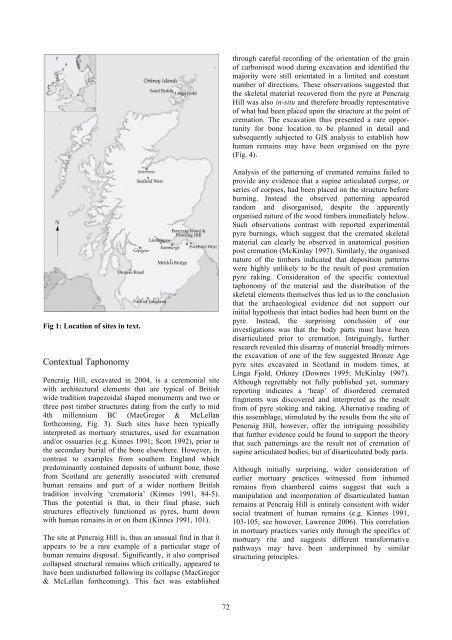The Materiality of Death - mikroarkeologi.se
The Materiality of Death - mikroarkeologi.se
The Materiality of Death - mikroarkeologi.se
You also want an ePaper? Increase the reach of your titles
YUMPU automatically turns print PDFs into web optimized ePapers that Google loves.
through careful recording <strong>of</strong> the orientation <strong>of</strong> the grain<br />
<strong>of</strong> carboni<strong>se</strong>d wood during excavation and identified the<br />
majority were still orientated in a limited and constant<br />
number <strong>of</strong> directions. <strong>The</strong><strong>se</strong> ob<strong>se</strong>rvations suggested that<br />
the skeletal material recovered from the pyre at Pencraig<br />
Hill was also in-situ and therefore broadly repre<strong>se</strong>ntative<br />
<strong>of</strong> what had been placed upon the structure at the point <strong>of</strong><br />
cremation. <strong>The</strong> excavation thus pre<strong>se</strong>nted a rare opportunity<br />
for bone location to be planned in detail and<br />
sub<strong>se</strong>quently subjected to GIS analysis to establish how<br />
human remains may have been organi<strong>se</strong>d on the pyre<br />
(Fig. 4).<br />
Fig 1: Location <strong>of</strong> sites in text.<br />
Contextual Taphonomy<br />
Pencraig Hill, excavated in 2004, is a ceremonial site<br />
with architectural elements that are typical <strong>of</strong> British<br />
wide tradition trapezoidal shaped monuments and two or<br />
three post timber structures dating from the early to mid<br />
4th millennium BC (MacGregor & McLellan<br />
forthcoming, Fig. 3). Such sites have been typically<br />
interpreted as mortuary structures, u<strong>se</strong>d for excarnation<br />
and/or ossuaries (e.g. Kinnes 1991; Scott 1992), prior to<br />
the <strong>se</strong>condary burial <strong>of</strong> the bone el<strong>se</strong>where. However, in<br />
contrast to examples from southern England which<br />
predominantly contained deposits <strong>of</strong> unburnt bone, tho<strong>se</strong><br />
from Scotland are generally associated with cremated<br />
human remains and part <strong>of</strong> a wider northern British<br />
tradition involving ‘crematoria’ (Kinnes 1991, 84-5).<br />
Thus the potential is that, in their final pha<strong>se</strong>, such<br />
structures effectively functioned as pyres, burnt down<br />
with human remains in or on them (Kinnes 1991, 101).<br />
<strong>The</strong> site at Pencraig Hill is, thus an unusual find in that it<br />
appears to be a rare example <strong>of</strong> a particular stage <strong>of</strong><br />
human remains disposal. Significantly, it also compri<strong>se</strong>d<br />
collap<strong>se</strong>d structural remains which critically, appeared to<br />
have been undisturbed following its collap<strong>se</strong> (MacGregor<br />
& McLellan forthcoming). This fact was established<br />
Analysis <strong>of</strong> the patterning <strong>of</strong> cremated remains failed to<br />
provide any evidence that a supine articulated corp<strong>se</strong>, or<br />
<strong>se</strong>ries <strong>of</strong> corp<strong>se</strong>s, had been placed on the structure before<br />
burning. Instead the ob<strong>se</strong>rved patterning appeared<br />
random and disorgani<strong>se</strong>d, despite the apparently<br />
organi<strong>se</strong>d nature <strong>of</strong> the wood timbers immediately below.<br />
Such ob<strong>se</strong>rvations contrast with reported experimental<br />
pyre burnings, which suggest that the cremated skeletal<br />
material can clearly be ob<strong>se</strong>rved in anatomical position<br />
post cremation (McKinlay 1997). Similarly, the organi<strong>se</strong>d<br />
nature <strong>of</strong> the timbers indicated that deposition patterns<br />
were highly unlikely to be the result <strong>of</strong> post cremation<br />
pyre raking. Consideration <strong>of</strong> the specific contextual<br />
taphonomy <strong>of</strong> the material and the distribution <strong>of</strong> the<br />
skeletal elements them<strong>se</strong>lves thus led us to the conclusion<br />
that the archaeological evidence did not support our<br />
initial hypothesis that intact bodies had been burnt on the<br />
pyre. Instead, the surprising conclusion <strong>of</strong> our<br />
investigations was that the body parts must have been<br />
disarticulated prior to cremation. Intriguingly, further<br />
re<strong>se</strong>arch revealed this disarray <strong>of</strong> material broadly mirrors<br />
the excavation <strong>of</strong> one <strong>of</strong> the few suggested Bronze Age<br />
pyre sites excavated in Scotland in modern times, at<br />
Linga Fjold, Orkney (Downes 1995; McKinlay 1997).<br />
Although regrettably not fully published yet, summary<br />
reporting indicates a ‘heap’ <strong>of</strong> disordered cremated<br />
fragments was discovered and interpreted as the result<br />
from <strong>of</strong> pyre stoking and raking. Alternative reading <strong>of</strong><br />
this as<strong>se</strong>mblage, stimulated by the results from the site <strong>of</strong><br />
Pencraig Hill, however, <strong>of</strong>fer the intriguing possibility<br />
that further evidence could be found to support the theory<br />
that such patternings are the result not <strong>of</strong> cremation <strong>of</strong><br />
supine articulated bodies, but <strong>of</strong> disarticulated body parts.<br />
Although initially surprising, wider consideration <strong>of</strong><br />
earlier mortuary practices witnes<strong>se</strong>d from inhumed<br />
remains from chambered cairns suggest that such a<br />
manipulation and incorporation <strong>of</strong> disarticulated human<br />
remains at Pencraig Hill is entirely consistent with wider<br />
social treatment <strong>of</strong> human remains (e.g. Kinnes 1991,<br />
103-105; <strong>se</strong>e however, Lawrence 2006). This correlation<br />
in mortuary practices varies only through the specifics <strong>of</strong><br />
mortuary rite and suggests different transformative<br />
pathways may have been underpinned by similar<br />
structuring principles.<br />
72
















